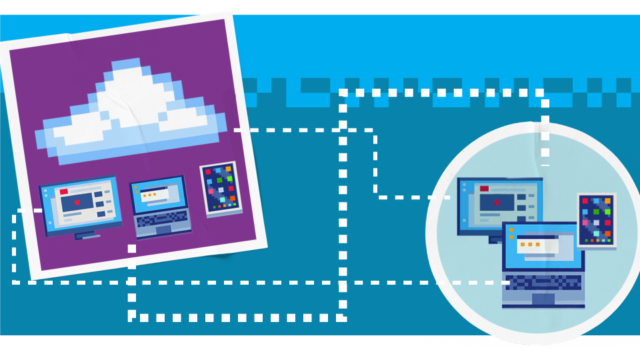Cloud computing isn’t just a trend; it has fast become the foundation of how modern businesses operate. As hybrid and remote work models become a cemented norm, organisations are turning to the cloud to ensure employees can securely access systems, files and data from anywhere.
But it’s not just about flexibility. Cloud adoption brings a host of business benefits: reduced infrastructure costs, improved scalability, greater reliability and access to cutting-edge tools that drive innovation and performance. If your organisation is still relying on traditional on-premises solutions, you could be missing out on the competitive advantages.
We know making the move to the cloud can feel overwhelming, especially without a clear plan. That’s why a well-thought-out migration strategy is essential. In this post, we’ll walk you through every step to ensure your cloud migration is smooth, secure and successful.
Is cloud migration always the right choice?
Before we dive into the steps to follow, let’s examine whether you should always move to the cloud.
In most cases, cloud computing is the future. It’ll enable you to get better access and visibility across tools and data, it will make AI adoption easier, it’ll promote agility and it’ll drive digital transformation. But, while cloud computing is advantageous for most businesses, there are some scenarios it may not be appropriate. This includes:
- If you face strict regulatory compliance: Some industries have stringent regulations regarding data sovereignty, security and control that might be easier to manage with on-premises solutions or private clouds. For example, financial institutions or healthcare providers might face complexities ensuring full compliance in a public cloud environment.
- If you require low latency: Applications that require extremely low latency, such as some high-performance computing tasks or real-time industrial control systems, might perform better with on-premises infrastructure. Network latency, even if minimal in the cloud, can be a limiting factor.
- If you have significant existing infrastructure: Companies that have recently made substantial investments in their on-premises IT infrastructure might not see an immediate cost benefit in migrating to the cloud.
- If you want maximum control: Some organisations prefer to have complete control over their IT infrastructure, including security protocols and hardware. Moving to the cloud, especially a public cloud, involves relinquishing some of that direct control.
It’s also worth remembering that you can employ a hybrid approach, with cloud technology in some business areas and not in others. This can enable you to obtain the benefits without losing control in specific areas, such as those held to compliance standards.
Before starting any cloud migration, it’s crucial to carefully consider the wider implications and ensure it will only affect your business positively.
Steps to a successful cloud migration
1. Define your goals and strategy
The crucial first step of any migration is to know why you’re moving to the cloud. The measurable outcomes you’re hoping to achieve will help you define the specific technologies you will leverage and your migration strategy, with emphasis on realising the set goals.
With goals defined, you’ll need to decide on your cloud deployment model: specifically private or public cloud (or a hybrid approach):
- Public cloud: A third-party provider makes computing resources, such as servers, storage and applications, available over the public internet. This offers scalability and a pay-as-you-go pricing model, relieving users from the burden of managing the underlying infrastructure.
- Private cloud: A cloud computing environment dedicated to a single organisation. This infrastructure can be hosted on-premises in the organisation’s data centre or by a third-party provider, offering enhanced control, security and customisation as resources are not shared with other entities.
- Hybrid cloud: Combines elements of public and private clouds, allowing data and applications to be shared between them. This model provides businesses with greater flexibility, enabling them to leverage the scalability and cost-effectiveness of the public cloud for certain workloads while keeping sensitive data or critical applications in a private environment.
A multi-cloud strategy, utilising services from multiple public cloud providers, is also an option for redundancy or leveraging specific strengths.
2. Define your cloud migration strategy
Finally, you need to formulate your migration strategy. There are a few options for how you can move your applications and data, including:
- Rehost: This strategy involves moving applications to the cloud without making significant changes. It’s often the quickest and simplest approach, where virtual machines or physical servers are essentially “lifted” from the existing environment and “shifted” to cloud-based virtual machines.
- Re-platform: This involves making a few cloud optimisations without fundamentally re-architecting the application. For example, you might migrate a database to a managed database service in the cloud or adopt a managed web server. The core architecture of the application remains largely the same.
- Re-architect: This strategy involves completely or significantly re-designing the application to take full advantage of cloud-native capabilities. This might include breaking down a monolithic application into microservices, using serverless functions or leveraging cloud-specific databases and services for better scalability, performance, and cost-efficiency.
- Repurchase: In some cases, it might be more strategic to replace an existing application with a cloud-based Software-as-a-Service (SaaS) offering that provides the required functionality. This eliminates the need to migrate the application itself.
- Retire: Before migrating, it’s essential to identify and decommission applications that are no longer needed. This “retire” strategy reduces the scope and complexity of the migration.
- Retain: For some applications, the best strategy might be to retain them in the existing on-premises environment. This could be due to regulatory requirements, latency issues or if the cost and effort of migration outweigh the benefits. These applications might still integrate with cloud-based services.
The approach you take, or mixture of approaches, will depend on your existing infrastructure and data, as well as your goals and resource for the project. So spend time picking yours, or even consider speaking to a cloud expert for guidance.
3. Assessment and planning
With your goals and strategy defined, the next phase is a deep dive into your current IT landscape. This begins with a comprehensive inventory of your assets, cataloguing all your applications, databases, servers, storage and network components. Understanding the interdependencies between these elements is critical.
Following this, you’ll need to conduct an application readiness assessment. Evaluate each application for its compatibility with the cloud, its performance requirements, and the potential complexity involved in migrating it. Some applications might be cloud-ready, while others may require modifications or even replacement.
A thorough data assessment is also essential. Understand the volume of your data, its sensitivity, any compliance requirements (like GDPR) and plan your data migration strategy.
You must also conduct security and compliance planning. Define how your security policies and regulatory obligations will be met in the cloud environment. This includes identity and access management, data encryption, and network security.
Finally, a detailed cost analysis will help you estimate the expenses associated with the migration itself, as well as the ongoing operational costs in the cloud.
The output of these assessment should be a detailed migration plan, outlining the timeline for each phase, assigning responsibilities to different teams and detailing the specific steps involved in migrating each application and data set.
4. Choose your cloud provider(s)
Selecting the right cloud provider(s) is a key decision. Each major provider offers a vast array of services, but they can differ in their strengths, pricing models and specific features. Your choice should be based on a careful evaluation of your technical requirements (e.g., specific services needed, performance demands), your budget, the service level agreements (SLAs) they offer, their security posture and their compliance certifications.
Consider factors like ease of use, the availability of specific technologies you need (like serverless computing or specific database types), and the provider’s ecosystem and community support. The provider you choose should align seamlessly with your previously defined goals and overall migration strategy.
5. Setup your cloud environment
Once you’ve selected your provider, the next step is to configure your cloud environment. This involves:
- Creating and setting up your cloud accounts
- Establishing your virtual private clouds (VPCs) or virtual networks to isolate your resources
- Implementing foundational security controls, such as firewalls, network segmentation and intrusion detection systems
Setting up a robust identity and access management (IAM) system is also crucial to control who can access what resources. From the outset, you should also configure comprehensive monitoring and logging services to gain visibility into the performance and health of your cloud environment. This will be invaluable for troubleshooting and maintaining optimal operations.
6. Migrate applications and data
This is where the actual moving of your workloads takes place, following the detailed plan you created earlier. You’ll execute your chosen migration strategy for each application and data set.
For example, you might rehost a virtual machine by creating an equivalent instance in the cloud and migrating the disk image. For databases, you might use managed database services and migrate your data using built-in tools. For cloud-native applications, you might deploy containerized applications using orchestration services like Kubernetes.
Crucially, after migrating each component, you must perform thorough testing to ensure it’s functioning correctly in the cloud, meeting performance targets and adhering to your security policies.
7. Validation and testing
After the migration phase, rigorous validation and testing are a must. This involves comprehensive testing of all migrated applications and data within the cloud environment.
This should include functional testing to ensure all features work as expected, performance testing to validate that applications meet the required speed and responsiveness under load, security testing to identify any vulnerabilities in the cloud configuration and user acceptance testing (UAT) to ensure that end-users are satisfied with the migrated systems.
Any issues or discrepancies identified during these testing phases must be addressed promptly and thoroughly.
8. Optimisation and go-live
With successful testing, the focus shifts to optimisation. During this stage, you’ll fine-tune your cloud resources to achieve the best balance of cost-efficiency and performance.
This might include right-sizing your compute instances to match actual usage, leveraging auto-scaling to dynamically adjust resources based on demand, optimizing your database queries or implementing cost-saving measures like reserved instances.
Once you’re confident in the performance and cost-effectiveness of your cloud environment, you can proceed with the go-live, which is the cutover from your old, on-premises environment to the new cloud infrastructure. This needs to be carefully orchestrated to minimise downtime and ensure a smooth transition for your users.
9. Post-migration and ongoing management
The journey to the cloud doesn’t end at go-live. Post-migration and ongoing management are critical for long-term success. This includes continuous monitoring of your cloud environment’s performance, security and costs.
You’ll need to establish processes for ongoing management tasks, such as applying updates, managing security patches and backing up your data.
Regularly reviewing your cloud usage and identifying opportunities for further optimisation will ensure you continue to realise the benefits of your cloud migration and adapt to evolving business needs and cloud technologies.
Getting started with your cloud migration with Microsoft Azure
Every successful cloud migration begins with a clear understanding of your current setup and a well-defined strategy. Taking time to assess your infrastructure, data and business goals will help you make informed decisions and avoid common pitfalls along the way.
If you’re exploring cloud platforms, Microsoft Azure is a great place to start. It’s a flexible, secure and scalable cloud environment used by organisations of all sizes to run applications, store data and build modern digital services. Whether you’re looking to improve performance, reduce costs or enable remote work, Azure offers a wide range of tools and services to support your goals.
Curious about what Azure can offer your business?
Download our comprehensive Microsoft Azure datasheet to learn more about its core capabilities, benefits and how it can support your cloud journey.





